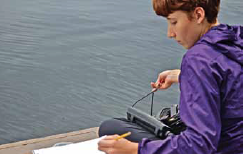- Have Any Question?
- 443-983-5232
- info@moosepondassociation.org
Advanced Water Testing Initiatives
- Home
- Advanced Water Testing Initiatives

Project Details
- Category : Water Quality
- Date : Summer 2014
- Status : Completed
- Tags : Water, Environment, Water Quality
- Live demo : None
- 15 Jul 2015
- Water Quality
Advanced Water Testing Initiatives
Water testing on Moose Pond is keeping up with the advances in lake science. And lake science may be the key to maintaining clean, clear water.
For the past two summers, LEA has amped up the water testing program on Moose Pond due to direct support from the Moose Pond Association. Assistant Director Colin Holme, and researcher Amanda Pratt, plus their crew of interns, have collected and analyzed concentrations of the blue-green algae Gloeotrichia echinulata, as well as aluminum and iron.
In the water, Gloeo looks like round pinhead-sized yellow-green dots, that resembles pine pollen, suspended throughout the water column.
As a cyanobacteria, Gloeo is associated with high nutrient lakes and thus bad water quality. Therefore, it came with great surprise during 2013 that this “bad” algae was found on Moose Pond. Pratt stated, however, that the “numbers in Moose Pond were fifteen times lower than the highest recorded level in Maine, from Long Pond in the Belgrade Lakes Region.”in 2013, the north and south basin sampling locations were added in 2014. A total of 23 samples were collected from these sites between June and September 2014. The north and south basins had low levels of the algae, with a maximum of 0.9 colonies per liter in the north and 1.5 colonies per liter in the south basin.
In the middle basin, the maximum was 16.2 colonies per liter, nearly identical to the 16.6 colony per liter peak at this site in 2013. The date of this peak was also nearly the same in both years, occurring within the first week of August. The middle basin Gloeotrichia peak came after two weeks of sustained higher temperatures, which likely triggered the algal growth. The average level in the middle basin was 6.2 colonies per liter (up from an average of 4.1 colonies per liter in 2013). This site had the fourth highest peak and average Gloeotrichia levels of the 24 lakes sampled.
LEA also took a core sample to test the ratio of aluminum (Al) to iron (Fe) present in the lake sediment. Reportedly, “this ratio has been shown to predict the risk of sediment phosphorus release in acidic lakes. A ratio under 3 indicates a high risk of phosphorus release, while a level above 3 indicates that phosphorus will be bound by aluminum, lessening the availability of phosphorus in the water column.”
The results indicated that the middle basin is most at risk with a ratio of Al:Fe less than 3, and the upper and lower basins are at moderate risk with a ratio of 3-6.
Phosphorus trapped in sediment plays a role in the life cycle of Gloeo and other algal growth. Increased amounts of phosphorus cause the Gloeo colonies that enter the water column to grow dramatically.
Though it is a naturally occurring nutrient in soil, historical uses of the land, plus ongoing development probably contributed to an excessive amount of phosphorus finding its way into the pond.
Based on the results of the past two years, the MPA has hired LEA to continue regular sampling of Gloeo. In addition, LEA will add baseline monitoring of all algal species—thus creating a more complete picture of Moose Pond’s ecosystem. The association has also contracted with LEA to expand the traditional water testing program in both the north and south basins, which includes taking chlorophyll and phosphorus samples. The historic collection of data will help LEA and MPA make informed decisions for Moose Pond.
We’re grateful to have a local organization that can carry out these important tests and is on the cutting edge of determining what steps we can take to avoid a decline in water quality.
